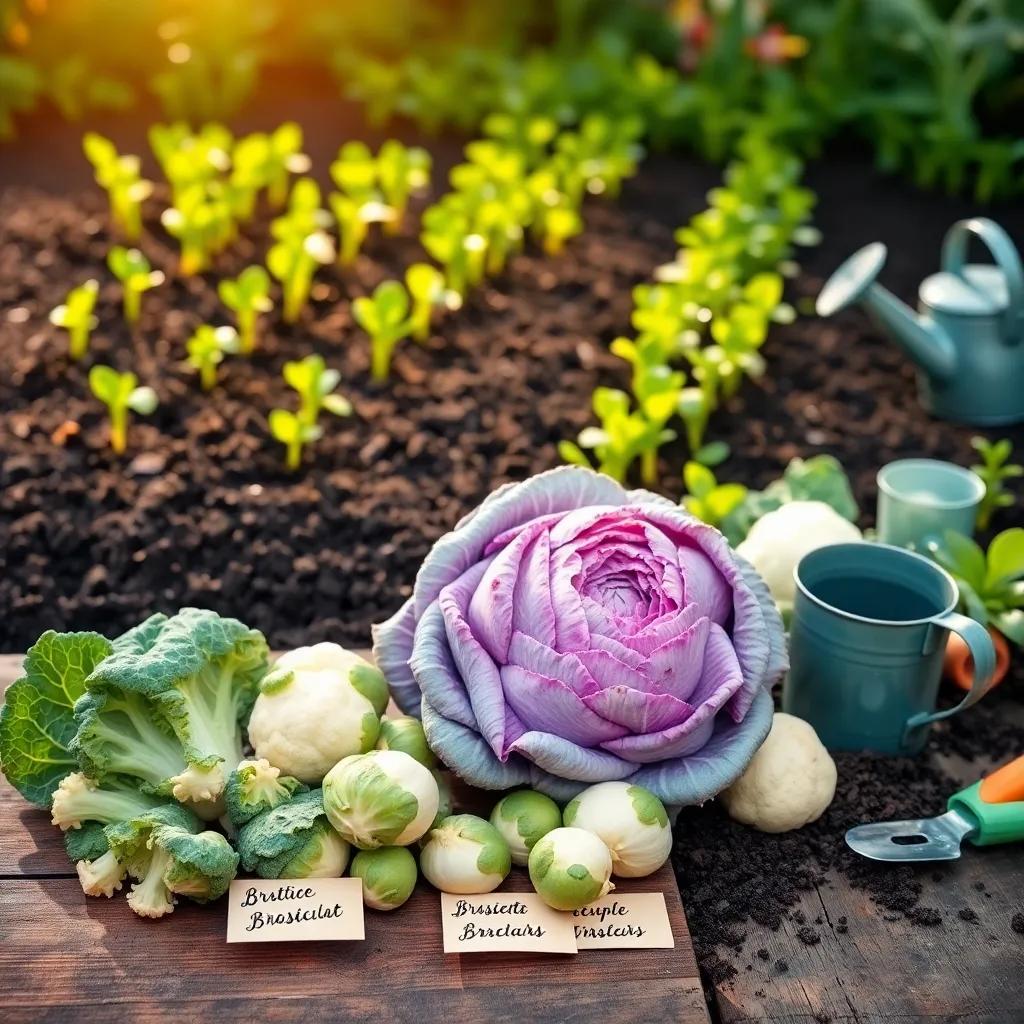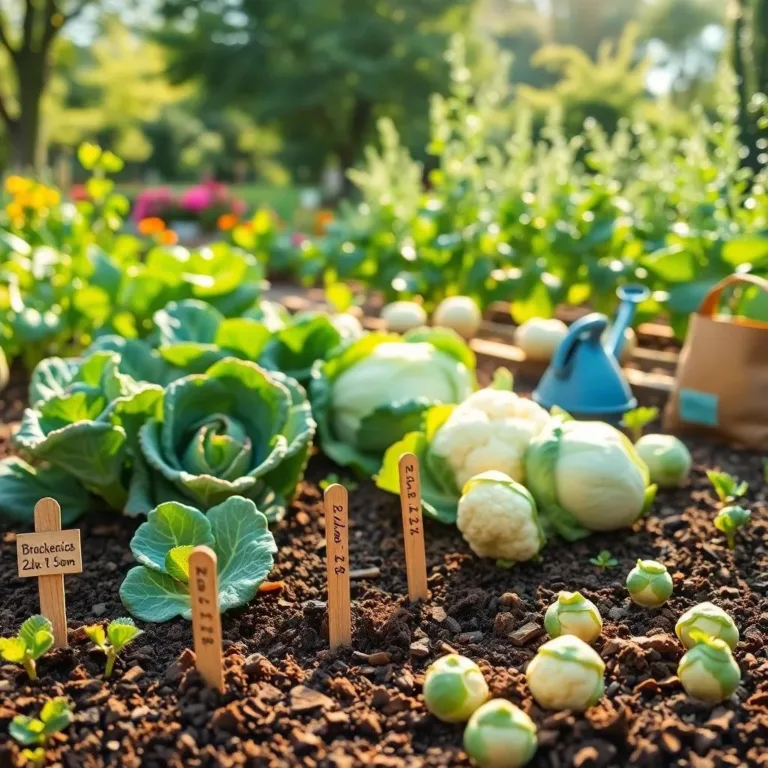Are you ready to grow your own delicious Brassicas? From kale to broccoli, these nutritious veggies are not only great for your health but are fun to cultivate! Join me as I share everything you need to know about getting those seeds to sprout and flourish in your garden! Let’s dig in!
Understanding Brassica Germination Requirements
Growing Brassicas like kale, cabbage, and broccoli is an exciting journey! But before we can enjoy those vibrant veggies, we need to understand what these seeds need to get started. Think of it as preparing for a little party in the soil!
To kick things off, moisture is one of the key ingredients for germination. Seeds need a cozy, damp environment to wake up and start growing. If the soil is too dry, the seeds might just chill out and take their sweet time. On the flip side, waterlogged soil is like a party gone wrong—too much moisture and your seeds could drown! Aim for consistently moist soil without any puddles.
Next up is temperature. Most Brassica seeds love warmth. They typically need temperatures between 55°F and 75°F (13°C to 24°C) to germinate properly. Think of this temperature range as their comfy blanket! You can help maintain this warmth by using row covers or planting them during the right season. Isn’t it amazing how little adjustments can make a big difference?
Now, let’s not forget about light. Most Brassica seeds don’t require light to germinate, but don’t let that fool you! Once they sprout, they’ll be stretching toward the sun like kids reaching for candy. So, while they’re cozy in the soil, keep the light in mind for after they emerge.
Finally, the quality of your seeds matters! Fresh, healthy seeds are like having the best ingredients for a delicious dish. Always choose seeds from reputable sources to give your plants the best chance at a lively start.
By understanding these basic requirements, you’re already setting the stage for a thriving garden. Get ready to enjoy the magic of growing your own Brassicas!
Germination Times for Popular Brassica Varieties
Now that we’ve laid the groundwork for our gardening journey, let’s talk about the germination times for some of the most popular Brassica varieties! Knowing how long each type takes to sprout can help us plan our planting and, of course, our future salads!
- Kale: If you’re a kale lover, you’ll be happy to know that these little seeds typically germinate within 5 to 10 days. They enjoy cooler temps, so keep the soil around 50°F to 65°F (10°C to 18°C) for the best results!
- Cabbage: These familiar green beauties usually sprout in 7 to 10 days. Cabbage seeds thrive best when the temperature hovers between 55°F and 75°F (13°C to 24°C).
- Broccoli: Broccoli seeds are a bit more patient, often taking 7 to 14 days to germinate. The temperature sweet spot is the same as cabbage, so keep those thermometers handy!
- Brussels Sprouts: These tasty gems take a little longer, typically germinating in 10 to 14 days. They love a wider temperature range, from 45°F to 80°F (7°C to 27°C).
- Cauliflower: Just like broccoli, cauliflower seeds also tend to germinate within 7 to 14 days. Keeping the soil temperature similar to cabbage and broccoli will do the trick!
Remember, each variety has its own personality! Factors like soil conditions and moisture can cause slight variations in germination times. But, with a little patience and care, you’ll soon see those little sprouts breaking through the soil, ready to grow into delicious veggies! Happy gardening!

Tips for Successful Brassica Seed Germination
Growing Brassicas can feel a bit like hosting a party—everyone needs the right conditions to shine! Here are some handy tips to help your seeds germinate successfully and get those plants off to a fantastic start!
- Choose Quality Seeds: Always pick fresh seeds from a reliable source. High-quality seeds are like the best ingredients in a recipe—they make all the difference!
- Prepare the Soil: Use a well-draining potting mix or garden soil. It should be light and airy. You want the soil to be like a cozy bed for the seeds, not a heavy blanket!
- Water Wisely: Keep the soil consistently moist but not soggy. A gentle spray from a watering can works great. Too much water can drown the seeds, while too little can leave them thirsty and lethargic.
- Control Temperature: Keep an eye on the temperature! Most Brassicas like it warm, so aim for 55°F to 75°F (13°C to 24°C). If it’s too cold, your seeds may take their time waking up!
- Plant at the Right Depth: Sow your seeds at the correct depth—usually about 1/4 to 1/2 inch (6 to 12 mm). Planting too deep can hinder germination, while too shallow can leave them exposed.
- Light it Up: After germination, make sure your seedlings get plenty of sunlight. If they start reaching for the sky, they might need more light!
With these tips, I’m sure your Brassica seeds will jump right up and flourish, just like the life of the party! Happy planting!
Factors Affecting Brassica Germination Rates
When growing Brassicas, I’ve learned that several factors can affect how quickly and successfully our seeds germinate. Recognizing these can help us troubleshoot and improve our gardening game!
Here are some key players:
- Temperature Extremes: If the soil is too hot or too cold, it can slow down or even stop germination. Keep that cozy range of 55°F to 75°F (13°C to 24°C) in mind!
- Moisture Levels: Inconsistent moisture can discourage seeds from sprouting. Too much rain? Seeds could drown. Not enough? They may dry up! I like to check the soil regularly to keep it just right.
- Seed Quality: Old or damaged seeds often have lower germination rates. Think of it like baking with stale flour—it just doesn’t work as well! Always choose fresh seeds for the best results.
- Seed Dormancy: Some seeds naturally resist germination until conditions are perfect. This can be a survival tactic! To encourage growth, you might need to use methods like stratification or scarification.
- Depth & Light: If seeds are planted too deeply or not buried enough to block out light, they might struggle to sprout. Most Brassica seeds can germinate in darkness, but once they break through, they’ll reach for sunlight!
By paying attention to these factors, I can help my Brassicas thrive from the get-go. Ready, set, germinate!
Post-Germination Care for Brassica Seedlings
Once those Brassica seeds have sprouted and are waving hello from the soil, it’s time to roll up my sleeves and give them the care they need to flourish into healthy plants. Just like nurturing a young athlete, my seedlings need love, attention, and the right environment!
- Watering Regularly: Keeping the soil consistently moist is essential! I check my plants daily to see if they need a drink. Remember, overly dry soil can stress them out, while too much water can lead to root rot. Aim for a happy medium!
- Providing Sunlight: As my seedlings grow, I make sure they get plenty of sunlight. Ideally, they should bask in bright, indirect light for 6-8 hours a day. If natural sunlight is scarce, I might consider using grow lights!
- Thinning Seedlings: Once my seedlings develop a couple of true leaves, it’s time to thin them out! This gives each plant enough space to flourish and prevents overcrowding. I gently pull out the weaker seedlings, leaving the strongest ones behind.
- Fertilizing Wisely: As my Brassicas grow, I often give them a boost with a balanced fertilizer. A little sprinkle can go a long way in providing essential nutrients for growth!
- Pest and Disease Monitoring: Keeping an eye out for pests like aphids or signs of disease is key. If I notice any unwelcome visitors, I’m quick to take action—whether that’s using insecticidal soap or removing affected leaves!
With these steps in place, my Brassica seedlings will have everything they need to grow strong and healthy. I can’t wait to see the delicious veggies they’ll produce! Happy gardening!

